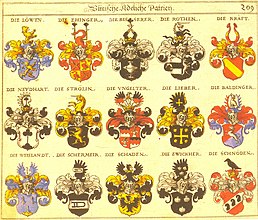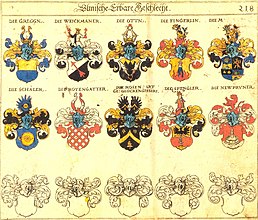Ulm patrician families
The patriciate of the imperial city of Ulm , the patrician families entitled to the leading positions in the city and territory , represented the actual center of power in the imperial city of Ulm until the Bavarian occupation in 1802.
history
The city development of Ulm seems to have taken place in stages since the 11th century, but without leaving any written records. The granting of Esslingen city rights by Rudolf von Habsburg in 1274 was probably more "an embarrassing solution to fill a [...] gap".
In the inner city, the first half of the 14th century was marked by civil war-like unrest, which was in connection with disputes between the guilds and the urban patriciate, which had largely emerged from former imperial officials and ruled. These families included the Besserer, Ehinger, Roth, Strölin, Krafft, Stammler and Gessler. In 1345 there was an interim solution in the form of the Small Oath, which temporarily led to a pacification of the situation by giving the guilds a decisive say in political and legal matters for the first time.
The Great Oath , the Ulm Guild Constitution , came into force in 1397 after the compromise in the Small Oath "became increasingly unsatisfactory". He regulated the distribution of power and the duties of the mayor. The guilds now had 30, the patricians only 10 council seats. At the same time, the patricians were denied the right to vote. The mayor, who regularly belonged to the patriciate, had to answer the residents. The Oath (penultimate Monday in July) has since been a Ulmer holiday. The patricians gathered in the “upper room” of the town hall, after which they named themselves “ room society ”.
In 1548, with the Augsburg Interim , Emperor Charles V initiated the abolition of the old guild constitutions in the imperial cities, which the imperial commissioner Heinrich Has replaced with new, patrician-dominated city constitutions based on the model of Nuremberg .
In order to distinguish themselves from the citizens of the guilds, 17 families were raised to the hereditary nobility by Charles V in 1552 . The Ulm patricians were recognized as "very noble comrades in the tournament and fiefdom and knightly people".
The oath of 1558 confirmed that the patricians had a majority in the council. Until the end of the imperial city, the leading positions in the city and territory were reserved for them. They appointed the two senior councilors, who had been appointed to head the city for life, held the office of mayor , which changes annually, and headed most of the imperial city offices. The Ulm Obervogteien in Geislingen an der Steige , Albeck , Langenau and Leipheim and the Oberforstamt in Altheim (Alb) were awarded exclusively to patricians.
Towards the end of the 17th century, the number of patrician families had fallen from 17 to eight due to extinction or the abandonment of civil rights (e.g. Neithardt 1658, Ungelter 1671, Stammler 1688). Some new families were reluctantly accepted. Around 1800 the patriciate of Ulm had twelve families.
With the Reichsdeputationshauptschluss of 1803, Ulm, which had already been occupied by Bavarian troops in 1802 , lost its imperial freedom and fell to the Electorate of Bavaria . In 1810, Ulm came to the Kingdom of Württemberg through a Bavarian-Württemberg area exchange . Martha Besserer von Talfingen, the last member of a patrician family to live in Ulm, died in 1980.
Coat of arms in the sieve maker
From Siebmacher's coat of arms 1605:
- Ulm Adeliche Patricii
- Ulmic Hereditary Sexes
Familys
- Baldinger , confirmed hereditary nobility in 1552
- Besserer (von Thalfingen) , verifiable since the 13th century, confirmed hereditary nobility in 1552
- Ehinger (von Balzheim), traceable since the 13th century, confirmed hereditary nobility in 1552
- Frick, recorded in the last decade of the imperial city
- Gassold, extinct in the 15th century
- Gessler, verifiable since the 13th century, confirmed hereditary nobility in 1552
- Günzburger, confirmed hereditary nobility in 1552
- Harsdörfer added, 1682, from Nuremberg to arise
- Hailbronner, 1774
- Krafft (von Dellmensingen) , traceable since the 13th century, confirmed hereditary nobility in 1552
- Dear, hereditary nobility confirmed in 1552
- Löw (also Löwen), confirmed hereditary nobility in 1552
- Neithardt (also Neidhardt, Neydhart, Neidhart or Neithart), died out in Ulm in 1658
- Neubronner , recorded in 1691
- Reiching, confirmed hereditary nobility in 1552
- Rehm, confirmed hereditary nobility in 1552
-
Roth (von Schreckenstein) , verifiable since the 13th century, confirmed hereditary nobility in 1552, too
- Roth from Reutti
- Roth von Holzschwang
- Schad (von Mittelbiberach), hereditary nobility confirmed in 1552
- Stupid, coming from Nuremberg
- Schermar (also Schermair), confirmed hereditary nobility in 1552
- Seutter , taken in 1716, originally from Kempten coming
- Stammler, traceable since the 13th century, confirmed hereditary nobility in 1552, died out in Ulm in 1688
- Strauss, recorded in the last decade of the imperial city
- Strölin, verifiable since the 13th century, confirmed hereditary nobility in 1552
- Ungelter, hereditary nobility confirmed in 1552, extinct in Ulm in 1671
- Weislandt (von Schwenningen), listed in the Siebmacher in 1605
- Welser was added in 1625, from Augsburg coming
- Wölkern, recorded in 1784, from Nuremberg
- Zwickher, listed in the Siebmacher in 1605
literature
- Hans Eugen Specker: Ulmer patricians and citizens , published on October 14, 2015, in: Historisches Lexikon Bayerns , accessed on June 29, 2018
Individual evidence
- ↑ Both quotations: Hans Eugen Specker: Ulm. City history. Ulm 1977, p. 38.
- ↑ Hans Eugen Specker: Ulm. City history. Ulm 1977, p. 53.
- ↑ This in perfect analogy to Geislingen an der Steige , where the old town hall was also built in 1422 by the imperial city of Ulm, cf. Archived copy ( memento of the original from March 22, 2009 in the Internet Archive ) Info: The archive link was inserted automatically and has not yet been checked. Please check the original and archive link according to the instructions and then remove this notice. .
- ^ Eberhard Naujoks: Charles V and the guild constitution. Selected files on the constitutional changes in the Upper German imperial cities (1547–1556). Publications of the commission for historical regional studies in Baden-Württemberg. Row A: Sources






